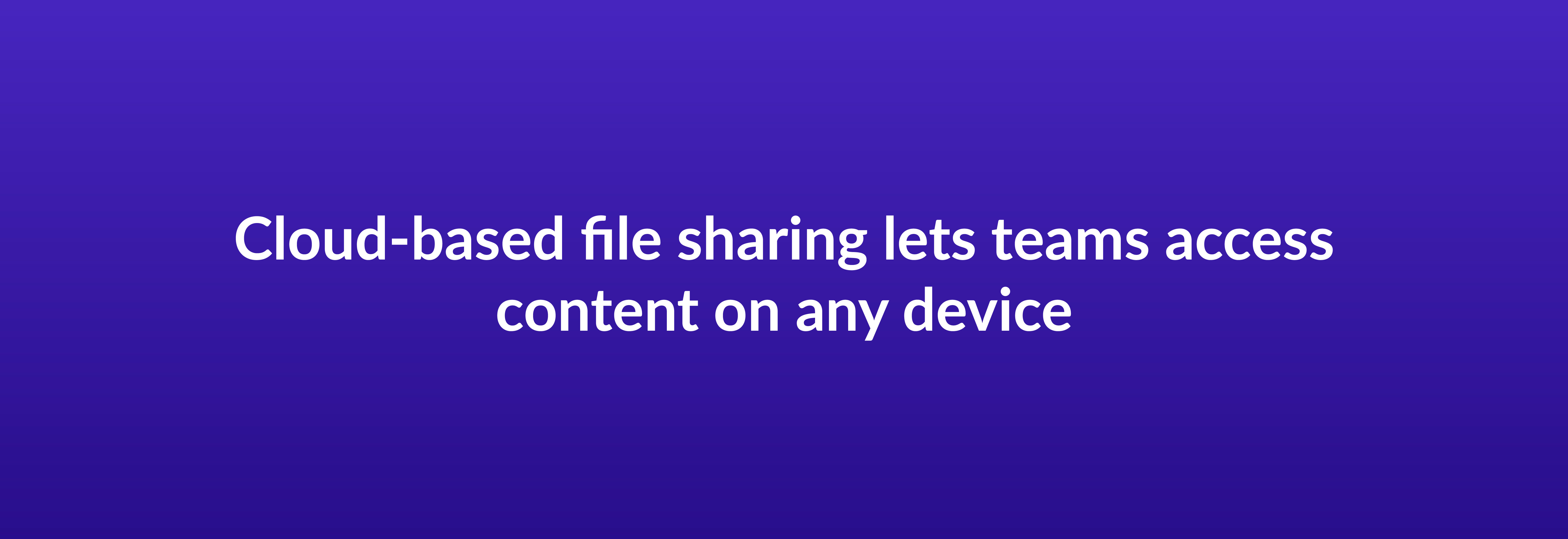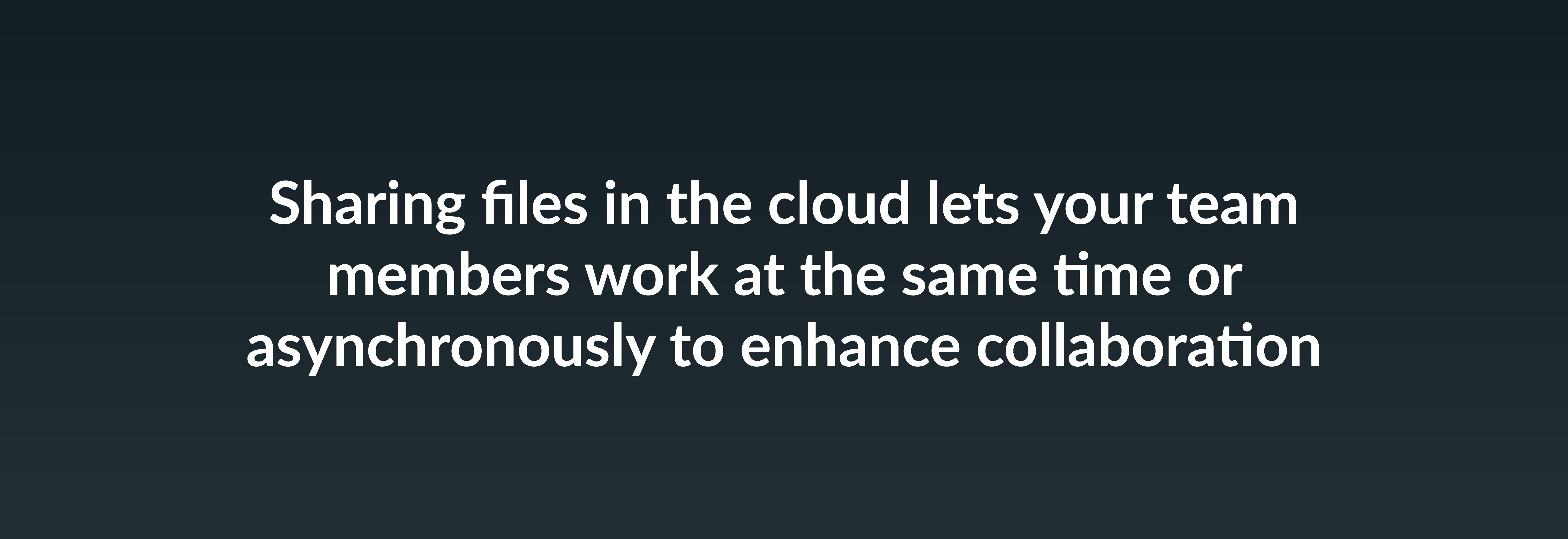The benefits of using a cloud-based file-sharing system
Creating, storing, and managing files are all tasks critical to your company's daily work. You need an accessible, effective way to share all of your content with your team so you can complete projects, whether you produce marketing materials or handle sensitive patient documents.
Did you know that as of 2022, over 60% of worldwide corporate data is in the cloud?
More organizations take advantage of the benefits of using a cloud-based file-sharing system. Cloud-based file sharing allows you to control which people can access, edit, or move the files your company stores and share those files with stakeholders in any location. This guide outlines the benefits of file sharing in the cloud to help you consider whether switching to cloud storage is best for your company.
What is cloud-based file sharing?
Cloud-based file sharing is a type of content storage and sharing method powered by the cloud. A cloud-based file system involves cloud storage and other services enabling people to create, store, edit, share, and synchronize their files.

Unlike on-premises file storage systems, file sharing in the cloud provides shared file access to teams in any geographic location. This system is ideal for workloads relying on shared files and allows teams to access content from any device.
The main benefits of cloud-based file sharing
More companies and organizations realize the benefits of file sharing through the cloud. These advantages include:
Accessibility
Perhaps the main benefit of cloud-based file sharing is content accessibility. When your company runs its content storage and other applications through on-premises servers, files are only accessible locally. Team members need to be on your company's premises to access the files stored in its in-house servers. Projects stall when someone can't access critical files. In-house servers also restrict your team to a single location.
With cloud-based file sharing, files are much easier to create, edit, and share. Instead of relying on on-premises servers and IT infrastructure, companies with a cloud-based file system make their content instantly accessible to any team members who need them. Cloud file systems are accessible through the internet, allowing your people to locate and open them from any location as long as they have a computer, tablet, or phone with an internet connection.
With a cloud-based file system, you can give file access to any person who needs it to complete their workload. Administrators provide security rights for specific files to the end users who need access, and people can share files through the cloud with anyone else inside the company or organization with permission. Whether cloud users are within the same building or across the world, the cloud makes file sharing quick and seamless.
Collaboration
Collaboration is critical for your company's success. An environment of effective collaboration leads to new ideas, increases engagement, and allows your people to solve problems faster.
But effective collaboration can be challenging for multiple reasons. Communicating via in-person meetings or email can be time-consuming. Teams using traditional office programs often find it difficult to track file versions, resulting in confusion and slow-downs.

The benefits of cloud collaboration are numerous. Using a file-sharing cloud for business workloads provides transformative opportunities for collaboration. Sharing files through the cloud enables remote teams to work synchronously or asynchronously and instantly share file updates or content wherever they are.
Live versioning keeps all your files updated, even when people in different locations are working on the same document in real time. The cloud facilitates up-to-the-minute collaboration by maintaining recent file versions for remote and hybrid teams in different locations.
A cloud-based file system also improves the ways your team collaborates. Storing files on the cloud brings your team closer and reduces communication barriers. Cloud-based file sharing also standardizes your file organization, which makes it easier for your team to access what it needs to spark innovation.
Cost reduction
Cost is one of the most significant downsides of using an on-premises file storage solution. The initial setup costs are high because you need to purchase and install large servers and hardware to store your files. The size of these servers depends on your company's file storage needs. Running on-premises servers also requires an in-house IT team that can manage and mitigate any issues that arise.
In contrast, cloud file sharing has a much lower setup cost. One of the main reasons why the cloud is cost effective is the reduced need for purchasing, installing, and maintaining on-premises servers.
Instead of your company storing and managing its files on-site, the cloud-service provider installs and maintains the hardware necessary to provide cloud file storage to its customers. The provider also handles the related overhead costs and eliminates the burden on your IT team.
Using a cloud-based file system also eliminates the cost of updating hardware. Cloud-service providers consistently update their solutions, installing security patches and replacing hardware as needed. The pay-as-you-go pricing model of cloud file storage also allows you to pay for only the storage you need.
Security
Understanding how to improve information security is critical for protecting your valuable content. The average cost of a data breach in the United States was $9.44 million in 2022, making cybersecurity a high priority for companies across industries. Hackers may use ransomware attacks and other viruses to access critical content. Your company files are also vulnerable to insider threats. People with legitimate access to files could have malicious intent to leak them for financial gain or could fall victim to phishing scams.
With cloud-based file sharing, you benefit from the robust security measures your cloud-service provider enacts. Tools like file encryption, zero-trust controls, and threat detection protect your files and securely control who has access to them. Your cloud-service provider also performs regular, automatic updates to maintain top security.
Scalability
Scaling your company is challenging with on-premises servers. If you need more file storage space, you have to buy and install the data servers capable of providing the performance you need. If your storage needs decline, you're stuck with unused server space but still paying to maintain the hardware and software.
A cloud-based file system makes scaling effortless. Cloud-service providers generally offer multiple storage plans that you can update as needed. Besides changing your payment plan, there are no other capital expenses for upgrading or downgrading the amount of storage your company needs.

User management
Visibility is key when managing who accesses your content and keeping those people accountable for how they use them. You need a secure environment in which to create, edit, publish, update, and archive files. User management tools are essential for tracking edits, actions, and other file changes across the content lifecycle.
Cloud storage allows you to manage the content lifecycle with greater insight. Cloud-based file sharing gives your administrators and IT team control over which files people can access.
Strong user authentication measures and information-rights management enable you to restrict access to specific files. These features ensure only people who have permission to access and edit a file can do so.
You can also use audit histories to track workflow progress and gain insight into each stage in the content lifecycle, making it easier to ensure accountability.
Centralization
Requesting paper documents from across your organization can waste valuable time. What's even worse: nearly completing a file and then realizing you overlooked a critical revision because you didn't have the right file version. An on-premises content storage system means you can lose track of the correct version of a document, resulting in lost time and missing edits.
Cloud-based file sharing allows you to maintain a single, accessible source of truth for your critical content. People can easily search for the file they need within the system, saving the time it would take to request a document from across the company and wait for its delivery.
Live versioning tracks the most recent edits, additions, and approvals so everyone stays on track. Centralizing files in one location — accessible from anywhere through the cloud — streamlines workflows and makes it easier for your teams to get more done.
Use cases for cloud-based file sharing
The robust benefits of file sharing in the cloud support companies in a wide range of use cases. Cloud file storage and sharing allow you to manage projects and individual pieces of content with greater visibility. The cloud also enables companies to archive and back up large quantities of critical content. Consider some of the most significant use cases for cloud-based file systems.
Content management
Managing the content lifecycle is a critical function for any company or organization. Your content can include anything from marketing materials and scanned images to contracts and spreadsheets. It's vital to ensure these files are accurate before sending them to the next stage in the lifecycle or publishing them. Your team needs to be able to efficiently create, edit, synchronize, and share files across the organization to ensure project completion.
A cloud-based file system lets your team instantly share and update content, streamlining their workflows and simplifying content management. You can handle, save, modify, and connect content throughout the lifecycle from your cloud-based file system's platform, gaining insight into every file as it moves through the workflow.
File archiving and backup
Emergencies like natural disasters, cyberattacks, and system failures spell trouble if your company doesn't have backup files. If you lose the only copy of critical files to one of these unexpected events, you may never get it back. That's why content backups are an essential part of file storage — backing up your content is critical for preventing data loss.
You'll also need a way to store files at the end of the content lifecycle when you archive the content. If you've decided not to refresh certain files, you need a way to separate them from your current content. You may also need to archive files for a specific amount of time to comply with industry regulations.

Many companies use file sharing in the cloud to simplify the file backup and archiving processes. Cloud-service providers can perform automatic file backups to other data servers within their systems so that if one server goes down, there's always a complete backup on another. You can also save all your out-of-date files in an organized and accessible location with cloud storage.
Storing large amounts of data
Your company's content storage needs are unique, but you probably have large quantities of data to manage and store. Your company likely handles several types of files, from documents and images to audio and video. File quantity and size significantly impact how easy it is to store content in on-premises servers. When your company outgrows its current storage capabilities, acquiring more space can be time-consuming and costly.
A cloud-based file system can handle any amount of data as long as you have the right storage plan. Companies use the cloud to easily upgrade their storage space and maintain massive quantities of content. Determine how much cloud storage you need to see how file sharing in the cloud can eliminate your content storage issues.
Remote or hybrid work
Remote and hybrid work are now normal for a significant portion of the U.S. workforce. According to a McKinsey report, 58% of job holders in the United States can work remotely at least some of the time.
Workers highly value the autonomy to choose where they work. McKinsey found that a flexible working arrangement is one of the top factors influencing whether someone accepts a job.
Storing files on on-premises data servers requires your team to work onsite. The cloud is what makes remote and hybrid work possible. Companies use the cloud's global reach and instant communication to enable hybrid or remote work and keep teams connected.
Project management
Project management involves planning and monitoring a project to ensure it progresses smoothly, on time, and under budget. Effective project management requires teams to have clear communication, an understanding of each person's responsibilities, and visibility into the project's status. Project managers face challenges with scheduling, meeting the timeline and budget, appropriately assigning tasks, and planning around risks.
Cloud-based file sharing gives companies and organizations greater visibility into their workflows and projects, empowering them to track and streamline each stage of a project. Project managers receive real-time project updates and notifications about file changes, helping them create a more realistic timeline. The cloud simplifies project management by allowing teams to collaborate from anywhere and have access to all the files and tools they need to complete their work.
Discover the power of the Content Cloud
With a single secure platform for all your content, Box enables you to manage the entire content lifecycle: file creation, co-editing, sharing, e-signature, classification, retention, and so much more. We make it easy for you to collaborate on content with anyone, both inside and outside your organization. Frictionless, enterprise-grade security and compliance are built into our DNA, so you get total peace of mind that your content is protected. And with 1,500+ seamless integrations — as well as a range of native capabilities, like Box Sign — the Content Cloud provides a single content layer that ensures your teams can work the way they want.
The Content Cloud is a game changer for the entire organization, streamlining workflows and boosting productivity across every team. Contact us today, and explore what you can do with Box.
**While we maintain our steadfast commitment to offering products and services with best-in-class privacy, security, and compliance, the information provided in this blogpost is not intended to constitute legal advice. We strongly encourage prospective and current customers to perform their own due diligence when assessing compliance with applicable laws.